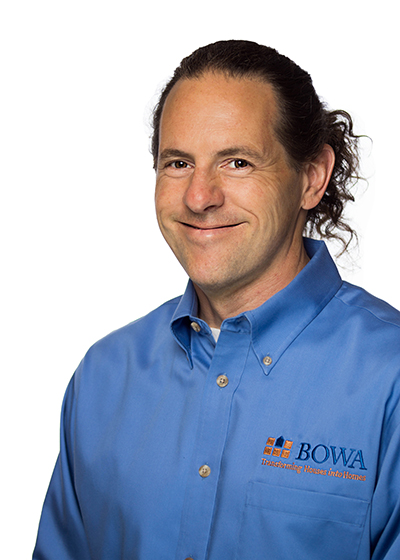BOWA Remodeling Expert Doug Horgan to Speak at National Home Performance Conference & Trade Show
Join BOWA’s Vice President of Best Practices, Doug Horgan, as he shares his leading expertise at the National Home Performance Conference & Trade Show April 8th through the 11th in Minneapolis, Minnesota. A leader in reducing construction defects through training and troubleshooting, Doug shares his experiences from over thirty years of tools-on carpentry, warranty troubleshooting, and instruction over 4 conference sessions.
Deflection, Drainage, and Drying: Building Walls That Work
Monday, April 8th
8:30 AM – 12:00 PM
Description:
Walls are hit with pouring rains, lashing winds, hot sun, and blowing snow. Keeping these all on the outside of the house is our challenge as builders. Traditional details help reduce these environmental loads and can be important for long-term longevity of finishes, but modern buildings also include backup systems to handle weather that gets past the outer layers. Durable walls are also built to dry rather than accumulate moisture. What are the materials used for the Water-Resistive Barrier (WRB), and how are they properly installed? How do we handle penetrations, windows, and connections to roofs and other adjacent assemblies? What methods are cost-effective for drainage & drying spaces? How are they drained to the outside of the structure? How do we install masonry, siding, stucco & EIFS, and other claddings to build durable buildings? Our company’s experiences with renovations, repairs, and mistakes on our own projects are the basis for this informative session.
Learning Objectives:
- Understand the purpose and key installation details of Water Resistive Barriers (WRBs) and drain cavity systems.
- Become familiar with flashing details for masonry, stucco, adhered stone, EIFS, and siding.
- Know key code requirements & online resources for supervisors & trade partners.
Basements & Crawlspaces: Problems & Solutions
Tuesday, April 9th
4:00 PM – 5:00 PM
Description:
Basement leaks are expensive & disruptive, and surprisingly common. Methods to prevent them in new construction, and solve them in existing buildings, are well known and understood. In this discussion we review several common systems for new and existing buildings including interior, exterior, and pre-applied waterproofing; drainage systems; and options for sump pumps & controllers.
Learning Objectives:
- Analyze common water and moisture problems in residential basements.
- Explain the typical waterproofing methods for new construction.
- Discuss options for retrofit and repair work to fix water issues.
Summer Moisture: Problems and Solutions
Wednesday, April 10th
10:00 AM – 11:00 AM
Description:
What are common summer time moisture issues? What tools are used to evaluate them? And what are the cures—whether the simple fix for the number one most common complaint, or seven figure repairs for complex ones?
A lot of the “building science” information we get was developed from cold-climate research, and the rules that work in wintertime don’t always apply in humid, warm summers.
As the climate changes, even northern states where air conditioning used to be unheard of are experiencing these conditions.
In this presentation, an experienced humid-summer builder from Washington, DC and a Minnesota high-performance builder share lessons learned over decades of evaluating, repairing, and most importantly preventing summer time moisture issues, along with resilient building methods appropriate for northern states which work in today’s winters and mitigate risks in future humid summers.
You’ll walk through case studies and get to discover the causes for common symptoms. Profusely illustrated with over 100 photos, and presented in an open discussion style so everyone can contribute.
Learning Objectives:
- Recognize the main principles of warm weather moisture, where it comes from, the forces that move it, and how to keep it where it causes no harm.
- Examine common moisture problems experienced in buildings in humid summer climates.
- Review wall, roof, and foundation construction materials and methods which are appropriate for humid-in-summer climates.
Building Diagnostic Tool: What, Why and How
Wednesday, April 10th
1:00 PM – 2:00 PM
Diagnostic tools can turn a contentious argument about “what the facts are” into a straightforward discussion of “how to fix this”.
What are the tools that stucco inspector or energy auditor is waving around? What are their uses and do they have blind spots?
You will learn how moisture meters, humidity and temperature data loggers, thermography, and blower doors can be used in building diagnostics.
Includes a live interactive demonstration showing how infrared cameras, pinless and pin-type moisture meters react to wet and dry materials.
Learning Objectives:
- Interpret readings from moisture meters, infrared cameras, hygrometers, and other tools; and understand their use in building diagnostics.
- Predict three ways to fool moisture measurement tools and how to get true readings.
- Describe common types of data loggers and their uses.
For more information regarding Doug Horgan at the National Home Performance Conference & Trade Show, click here.
Connect with Doug on LinkedIn.
OTHER POSTS

